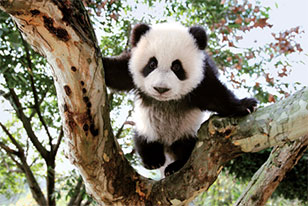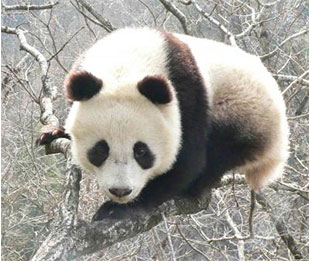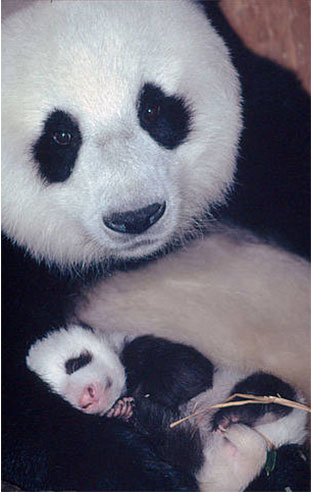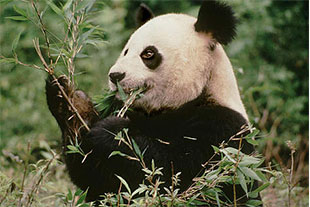

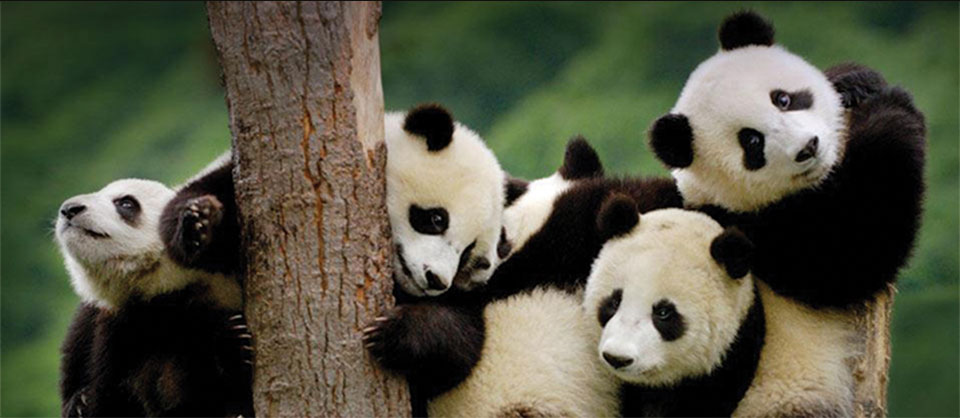
The giant panda is perhaps the most powerful symbol in the world when it comes to species conservation.In China, it is a national treasure, and for WWF the panda has a special significance since it has been the organization's symbol since 1961 when WWF was formed.
The panda is not special just because it is one of the most well known and charismatic animals. It is also a very peculiar species, with many unique and very interesting characteristics.
By 2004, there were estimated to be 1,600 pandas alive in the wild.
How does this compare to past figures? In the first ever mass survey that took place between 1974-1977, the researchers estimated that there were around 1,000 -1,100 giant pandas in the wild. In the 2nd ever survey, done between 1985-1988, again, around 1,000 animals were thought to exist.
Pandas live mainly bamboo forests high in the mountains of western China. Most of the wild population being distributed between the Minshan and Qinling Mountains.

The Minshan Mountains flank the eastern edge of the Tibetan Plateau, the highest and biggest plateau in the world.
These mountains form a natural barrier between the densely populated southern and eastern provinces of China and the great wilderness of the Tibetan Plateau to the west.
WWF has identified the Minshan Mountain range in Sichuan and Gansu provinces as a particularly important landscape for biodiversity: Its magnificent forests are home to a stunning array of wildlife besides the giant panda, such as dwarf blue sheep and beautiful multi-coloured pheasants.
There are around 720 pandas in the Minshan Mountains, 45% of the total wild population. PingWu county, in the Minshan Mountain area, has the highest density of pandas in the wild.

The Qinling Mountains, in the Shaanxi Province, forms a natural barrier between northern and southern China and protects the south from the cold northern weather and warm rains on the southern slopes support a rich variety of plants and animals.
It is an important watershed for China as a drop of rain in the Qinling Mountains, could end up in one of country's two great rivers, the Yangtze or the Yellow.
There are around 200-300 hundred pandas in the Qinling Mountains, 20% of the total wild population. The region is also home to a number of other endangered species, including the golden monkey, takin and crested ibis.
Giant pandas are about 150cm long from nose to rump, with a 10-15cm tail.
A large adult panda can weigh about 100-150kg, with males 10% larger and 20% heavier than females.
Distinctive black and white coat. Read a tibetan folklore tale on how pandas got their colour.
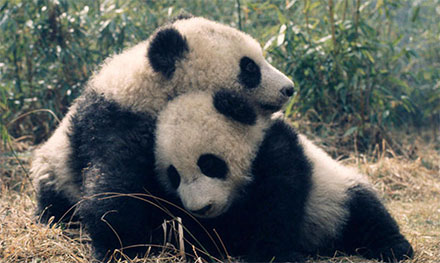
Giant pandas are generally solitary, each adult having a well-defined home range, within which they move about regularly.
Although they are not territorial, females do not tolerate other females and sub-adults within the core areas of their range.
Encounters are rare outside the brief mating season, but pandas communicate fairly often, mostly through vocalization and scent marking.
As the animals move about, they mark their routes by spraying urine, clawing tree trunks, and rubbing against objects.
Pandas are erroneously believed to be poor breeders.
This is an impression based on the disappointing reproductive performance of captive pandas.
But wild panda populations involved in long-term studies are known to have reproductive rates comparable to those of some populations of American black bears, which are thriving.
Giant pandas reach sexual maturity at 5.5 to 6.5 years.
A female can mate with several males, who compete with each other to mate with her.
A male will seek out different females who are on heat.
The mating season is in spring between March and May.
Males and females usually associate for no more than 2 to 4 days.
Gestation takes about 95 to 160 days and pandas normally give birth to single young (twins seem to be born more frequently in captivity, when artificial insemination is used).
The reproductive rate is about 1 young every 2 years
A Panda's daily menu consists almost entirely of the leaves, stems, and shoots of various bamboo species.
Bamboo contains very little nutritional value, so pandas must eat 12-38kg every day to meet their energy needs.
Only about 1% of their diet is made up of other plants and meat. Occasionally the panda will hunt for pikas and other small rodents.
As members of the bear family, giant pandas possess the same digestive system of a carnivore. But they differ in the sense that they have adapted to a vegetarian diet.
This behaviour defines their lives in many ways, since they will often rely on living close to areas where bamboo is abundant. This leaves them vulnerable to any loss of bamboo habitat – a key threat to their survival.
